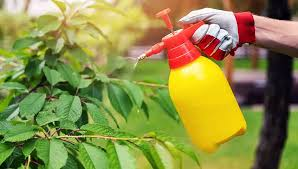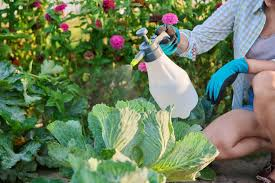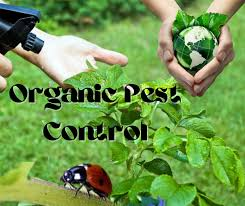Organic pest control is an environmentally friendly approach to managing garden pests without synthetic chemicals. It focuses on using natural methods and materials to control pest populations while maintaining ecological balance. This approach protects beneficial insects, soil health, and the overall environment.
The cornerstone of organic pest control is prevention. By creating a healthy and diverse garden environment, gardeners can reduce the likelihood of pest problems. This involves selecting pest-resistant plant varieties, rotating crops, and using companion planting to deter pests. Healthy plants are less vulnerable to pests, so maintaining good soil health through composting and organic fertilizers is crucial.
Biological control is a key strategy in organic pest control. This involves using natural predators, parasites, or pathogens to control pest populations. Beneficial insects such as ladybugs, lacewings, and predatory beetles feed on aphids, mites, and other common garden pests. Introducing these beneficial insects into the garden can help keep pest numbers in check. Birds, bats, and other wildlife can also be encouraged to visit the garden, as they naturally feed on insects.
Mechanical control methods are another important aspect of organic pest control. These methods physically remove or exclude pests from plants. Hand-picking pests like beetles and caterpillars can be effective in small gardens. Barriers such as row covers, netting, and copper tape can prevent pests from reaching plants. Traps, like sticky traps or pheromone traps, can capture insects and reduce their populations.
Cultural practices play a significant role in organic pest control. These include proper planting techniques, crop rotation, and maintaining garden hygiene. Spacing plants correctly allows for good air circulation, reducing the risk of fungal diseases. Removing plant debris and weeds can eliminate hiding places for pests. Crop rotation prevents pests from establishing themselves in the soil and reduces the buildup of pest populations.
Natural pesticides derived from plants or minerals can be used when pest populations become problematic. Neem oil, derived from the neem tree, disrupts the life cycle of many insects. Insecticidal soaps, made from natural fats and oils, can effectively control soft-bodied insects like aphids and mites. Diatomaceous earth, a powder made from fossilized algae, can be sprinkled around plants to deter crawling insects. These natural pesticides are less harmful to beneficial insects and the environment than synthetic chemicals.
Beneficial nematodes are microscopic worms that can be introduced into the soil to control soil-dwelling pests. They seek out and infect pests like grubs and caterpillars, effectively reducing their populations. These nematodes are safe for plants, humans, and pets, making them an excellent tool for organic pest control.
Encouraging biodiversity in the garden is essential for organic pest control. Planting a variety of flowers, herbs, and vegetables creates a habitat for beneficial insects and wildlife. Plants like marigolds, garlic, and nasturtiums can repel pests, while others like dill, fennel, and yarrow attract beneficial insects. Creating a diverse garden ecosystem helps maintain a natural balance between pests and their predators.
Organic pest control is a sustainable and effective approach to managing garden pests. By focusing on prevention, biological control, mechanical methods, cultural practices, and natural pesticides, gardeners can protect their plants without harming the environment. This holistic approach promotes a healthy and balanced garden ecosystem, ensuring long-term pest control and a thriving garden.
Principles of Organic Pest Control

1. Prevention: The first step in organic pest control is to prevent pest problems before they start. This involves maintaining healthy soil, choosing pest-resistant plant varieties, and practicing crop rotation.
2. Monitoring: Regularly inspect plants for signs of pests. Early detection allows for timely and effective intervention.
3. Biological Control: Utilize natural predators and beneficial insects to manage pest populations. Examples include ladybugs, predatory mites, and parasitic wasps.
4. Mechanical Control: Use physical methods like hand-picking pests, using traps, and barriers to protect plants.
5. Botanical Pesticides: Employ natural pesticides derived from plants, such as neem oil, pyrethrum, and diatomaceous earth.
6. Cultural Practices: Implement gardening practices that reduce pest habitat and disrupt their life cycles, such as proper spacing, pruning, and sanitation.
Steps to Implement Organic Pest Control
1. Soil Health: Improve soil health by adding compost and organic matter. Healthy soil produces strong plants that are more resistant to pests.
2. Plant Selection: Choose pest-resistant plant varieties and native plants that are well-adapted to your local environment.
3. Companion Planting: Grow plants together that benefit each other by repelling pests or attracting beneficial insects. For example, planting marigolds with tomatoes can deter nematodes.
4. Biological Controls: Introduce beneficial insects like ladybugs, lacewings, and nematodes that prey on pests. Ensure they have suitable habitats to thrive.
5. Physical Barriers: Use row covers, nets, and fences to keep pests away from plants. Hand-pick larger pests like caterpillars and beetles.
6. Natural Pesticides: Apply natural pesticides such as neem oil, insecticidal soap, and diatomaceous earth as needed. Always follow the instructions for safe use.
7. Regular Monitoring: Inspect plants regularly for pest damage. Early detection and intervention can prevent larger infestations.
Read Also: How Much Does It Cost to Adopt a Pet
Benefits of Organic Pest Control

1. Environmental Health: Organic pest control methods reduce pollution by avoiding synthetic chemicals that can harm soil, water, and beneficial organisms. They promote a healthier ecosystem and contribute to biodiversity.
2. Human Health: By avoiding synthetic pesticides, organic pest control reduces the risk of pesticide residues on food, which is beneficial for human health. Organic methods also minimize exposure to potentially harmful chemicals.
3. Sustainable Practices: Organic pest control supports sustainable agriculture by using practices that enhance soil health and ecosystem balance. This can lead to improved crop resilience and reduced dependency on chemical inputs.
4. Enhanced Soil Fertility: Many organic pest control methods, such as using organic compost and cover crops, improve soil fertility and structure, leading to healthier plants that are better able to withstand pest pressures.
Common Organic Pest Control Methods
1. Biological Controls: This method uses natural predators, parasites, and pathogens to control pest populations. Examples include releasing ladybugs to control aphids or introducing nematodes to target soil-dwelling pests.
2. Cultural Practices: These practices involve altering farming methods to make the environment less conducive to pest problems. Techniques include crop rotation, companion planting, and selecting pest-resistant plant varieties.
3. Mechanical Controls: Mechanical controls involve physical methods to manage pests. This includes using traps, barriers, and hand-picking pests. For example, using row covers to protect plants from insects or employing sticky traps for monitoring and controlling pests.
4. Organic Pesticides: Organic pesticides are derived from natural sources and are used as a last resort when other methods are insufficient. Examples include neem oil, insecticidal soap, and diatomaceous earth.
A. Biological Controls
1. Predators: Introducing or encouraging natural predators, such as birds, spiders, and beneficial insects like ladybugs, can help control pest populations. For instance, lacewings feed on aphids and other small insects.
2. Parasites: Certain parasites lay eggs on or inside pests, eventually killing them. Parasitic wasps are commonly used to target pests like whiteflies and caterpillars.
3. Pathogens: Beneficial microorganisms, such as bacteria, fungi, and viruses, can be used to infect and kill pests. For example, the bacterium Bacillus thuringiensis (Bt) is effective against various larvae.
B. Cultural Practices
1. Crop Rotation: Rotating crops disrupts pest life cycles by preventing pests from establishing a foothold. Different crops can also reduce the build-up of soil-borne pests and diseases.
2. Companion Planting: Planting certain species together can repel pests or attract beneficial insects. For example, marigolds can deter nematodes, while planting basil near tomatoes can repel aphids.
3. Resistant Varieties: Selecting plant varieties that are resistant to common pests can reduce the need for intervention. Breeding and selecting pest-resistant strains contribute to effective pest management.
C. Mechanical Controls
1. Traps: Various types of traps, such as pheromone traps and sticky traps, can capture and monitor pest populations. Traps help reduce pest numbers and provide insights into pest activity.
2. Barriers: Physical barriers, such as row covers and nets, can protect plants from pests. These barriers prevent insects from reaching crops and can also shield plants from larger pests like rabbits.
3. Hand-Picking: Manually removing pests from plants can be effective for small infestations. Hand-picking caterpillars or beetles reduces their numbers without chemicals.
D. Organic Pesticides
1. Neem Oil: Derived from the neem tree, neem oil acts as an insect repellent and disrupts the life cycle of pests. It is effective against aphids, whiteflies, and other soft-bodied insects.
2. Insecticidal Soap: Made from natural plant oils and fats, insecticidal soap targets soft-bodied insects like aphids and spider mites. It works by suffocating the pests.
3. Diatomaceous Earth: This natural powder, made from fossilized algae, works as a desiccant that dries out and kills pests like fleas and ants when they come into contact with it.
How to Implement Organic Pest Control
1. Assessment and Monitoring: Regularly monitor plants for pests and diseases. Use traps and visual inspections to identify pest problems early.
2. Integrated Approach: Combine various pest control methods to create a comprehensive management plan. Use biological controls, cultural practices, and mechanical controls in conjunction with organic pesticides when necessary.
3. Record-Keeping: Keep detailed records of pest populations, control measures, and outcomes. This helps in evaluating the effectiveness of different methods and adjusting strategies as needed.
4. Education and Training: Stay informed about the latest organic pest control techniques and innovations. Participate in workshops and consult with experts to enhance your pest management skills.
Challenges and Considerations
1. Effectiveness and Coverage: Organic pest control methods may not always provide immediate or complete pest eradication. It requires a combination of methods and persistence.
2. Cost and Labor: Organic pest control can be labor-intensive and may involve higher costs for certain methods, such as purchasing beneficial insects or organic pesticides.
3. Knowledge and Expertise: Implementing organic pest control effectively requires knowledge and expertise. Farmers and gardeners must stay informed about best practices and adapt to changing pest dynamics.
4. Pest Resistance: Over time, pests may develop resistance to certain organic control methods. Diversifying control strategies and regularly rotating methods can help manage resistance.
Organic pest control offers a sustainable and environmentally friendly approach to managing pests in agriculture. By leveraging biological controls, cultural practices, mechanical methods, and organic pesticides, growers can effectively protect crops while minimizing environmental impact. Successful implementation requires careful planning, monitoring, and a willingness to adapt strategies based on experience and ongoing research. Despite challenges, the benefits of organic pest control make it a valuable component of sustainable farming practices.
Read Also: Burmese Cat Breed (Felis catus) Description and Complete Care Guide
Frequently Asked Questions (FAQs) About Organic Pest Control

1. What is organic pest control?
Organic pest control involves managing pests using natural methods and substances, avoiding synthetic chemicals to protect human health and the environment.
2. How does organic pest control differ from conventional pest control?
Organic pest control relies on natural predators, biological controls, and botanical pesticides, while conventional pest control often uses synthetic chemicals that can harm beneficial organisms and the environment.
3. What are the main benefits of organic pest control?
The main benefits include reduced chemical exposure, safer produce, environmental protection, cost savings, and meeting consumer demand for organic products.
4. Are organic pest control methods effective?
Yes, when used correctly, organic pest control methods can be highly effective. Success depends on regular monitoring, timely intervention, and a combination of different techniques.
5. Can I use organic pest control in my home garden?
Yes, organic pest control is ideal for home gardens. It ensures safe, chemical-free produce and protects beneficial insects and the environment.
6. What are some common natural pesticides?
Common natural pesticides include neem oil, insecticidal soap, pyrethrum, and diatomaceous earth. These are derived from plants or minerals and are safer for the environment.
7. How do I attract beneficial insects to my garden?
Attract beneficial insects by planting a variety of flowers, herbs, and shrubs that provide nectar and pollen. Avoid using broad-spectrum pesticides that can harm these beneficial organisms.
8. Is organic pest control more labor-intensive?
Organic pest control can be more labor-intensive due to practices like hand-picking pests, regular monitoring, and implementing multiple control methods. However, the benefits often outweigh the extra effort.
9. Can organic pest control be used on a large scale?
Yes, organic pest control can be used on a large scale. Many commercial organic farms successfully implement these methods, often combining them with other sustainable farming practices.
10. How do I get started with organic pest control?
Start with improving soil health, selecting pest-resistant plants, and monitoring your garden regularly. Introduce beneficial insects, use physical barriers, and apply natural pesticides as needed.
Read Also: How to Study For a Test

